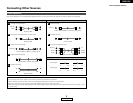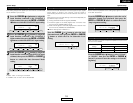
ENGLISH
14
System Setup System Setup
ENGLISH
5
Press the CURSOR
FF
or
GG
button to set the
distance from the surround R speakers to the
listening position, then press the ENTER or
CURSOR
HH
button to switch to the surround
back L speaker setting.
6
Press the CURSOR
FF
or
GG
button to set the
distance from the surround back L speakers to
the listening position, then press the ENTER or
CURSOR
HH
button to switch to the surround
back R speaker setting.
7
Press the CURSOR
FF
or
GG
button to set the
distance from the surround back R speakers to
the listening position, then press the ENTER or
CURSOR
HH
button to switch to the subwoofer
setting.
8
Press the CURSOR
FF
or
GG
button to set the
distance from the subwoofer to the listening
position, then press the ENTER or CURSOR
HH
button to enter the setting and switch to the
Subwoofer Mode setting.
• The number changes in units of 1 foot each time one of the
buttons is pressed. Select the value closest to the measured
distance.
• The difference in distance for the various speaker settings
must not be greater than 20 ft.
Setting the Subwoofer Mode and
Crossover Frequency
1
Press the CURSOR
FF
or
GG
button to select the
subwoofer mode, then press the ENTER or
CURSOR
HH
button to enter the setting and
switch to the crossover frequency setting.
*SW Mode Norm
Norm +Main
2
Press the CURSOR
FF
or
GG
button to select the
crossover frequency, then press the ENTER or
CURSOR
HH
button to enter the setting and
switch to the Test Tone setting.
*Cr.Over 80Hz
60Hz 80Hz
200Hz 180Hz 150Hz
100Hz
120Hz 135Hz
Set the subwoofer mode and crossover frequency mode
according to the speaker system being used.
2 Assignment of low frequency signal range
The signals produced from the subwoofer channel are LFE
signals (during playback of Dolby Digital or DTS signals) and the
low frequency signal range of channels set to “SMALL” in the
setup. The low frequency signal range of channels set to
“LARGE” are produced from those channels.
2 Crossover Frequency
• When “Subwoofer” is set to “Yes” at the “Speaker
Configuration” setting, set the frequency (Hz) below which the
bass sound of the various speakers is to be output from the
subwoofer (the crossover frequency).
• For speakers set to “Small”, sound with a frequency below
the crossover frequency is cut, and the cut bass sound is
output from the subwoofer instead.
(• When “Subwoofer” is set to “No”, the bass sound is output
from the speakers set as “Large”.)
NOTE:
• For ordinary speaker systems, we recommend setting the
crossover frequency to 80 Hz. When using small speakers,
however, setting the crossover frequency to a higher
frequency may improve frequency response for frequencies
near the crossover frequency.
2 Subwoofer Mode
• The subwoofer mode setting is only valid when “Large” is set
for the front speakers and “Yes” is set for the subwoofer in
“Setting the Speaker Configuration” ( page 12, 13).
• When the “LFE+MAIN” playback mode is selected, the low
frequency signal range of channels set to “Large” is produced
simultaneously from those channels and the subwoofer
channel.
In this playback mode, the low frequency range expands more
uniformly through the room, but depending on the size and
shape of the room, interference may result in a decrease of the
actual volume of the low frequency range.
• Selection of the “LFE” play mode will play the low frequency
signal range of the channel selected with “Large” from that
channel only. Therefore, the low frequency signal range that is
played from the subwoofer channel is only the low frequency
signal range of LFE (only during Dolby Digital or DTS signal
playback) and the channels specified as “Small” in the setup
menu.
• Select the play mode that offers the fullest bass.
• When the subwoofer is set to “Yes”, bass sound is output from
the subwoofer regardless of the subwoofer mode setting in
surround modes other than Dolby/DTS.
• In surround modes other than Dolby Digital and DTS, if the
subwoofer is set to “Yes”, the low frequency portion is always
output to the subwoofer channel. For details, refer to
“Surround modes and parameters” ( page 43).


















